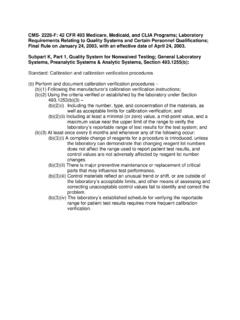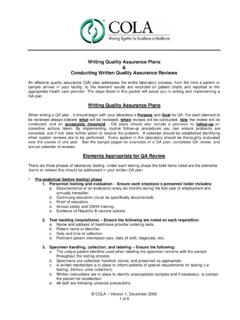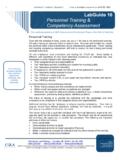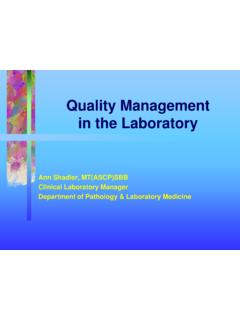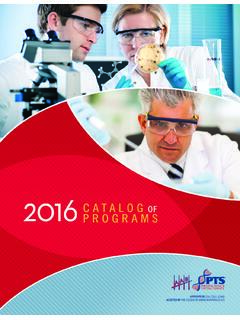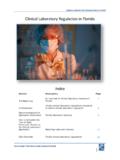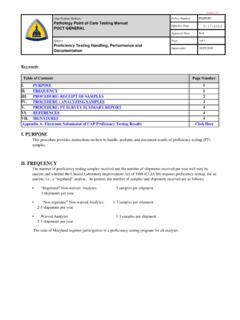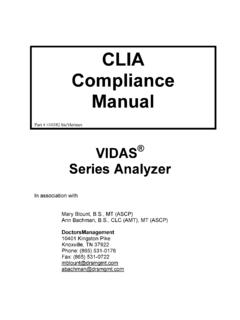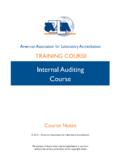Transcription of Guidelines and Regulations - Audit MicroControls
1 Calibration Verification - Guidelines and RegulationsPresentation Topics & Objectives Define difference between Calibration and Calibration Verification What are acceptable Calibration Verification materials How and when Calibration Verification is to be performed Troubleshooting for a failed Calibration VerificationLet s Start From the Beginning January 24th, 2003 Centers for Disease Controland Prevention (CDC) and the Centers forMedicare & Medicaid (CMS) publish laboratoryregulations (CLIA) to become effective April24th, 2003 Include requirements for Calibration andCalibration Verification for nonwaived tests Nonwaived tests include moderately and highcomplexity testsDiscussion of Terminology Definitions and applications of following: Calibration Calibration Verification Reportable Range Analytical Measurement Range (AMR)Definitions Calibration: is the process of testing andadjusting the instrument or test systemreadout to establish a correlation between theinstrument s measurement of the substancebeing tested and the actual concentration ofthe substance Basically Tells the instrument how to read acertain level of the analyte being testedDefinitions Continued Calibration Verification: means testingmaterials of known concentration in the samemanner as patient specimens to assure thetest system is accurately measuring samplesthroughout the reportable rangeDefinitions Continued Reportable Range.
2 The span of test result values over which the laboratory can establish or verify the accuracy of the instrument or test system measurement responseDefinitions Continued Analytical Measurement Range (AMR): Defined by CAP (College of American Pathologists) as the range of numeric results a method can produce without any special specimen pre-treatment, such as dilution, that is not part of the usual analytic process. (Same as reportable range in CLIA terminology.) Definitions Continued Linearity As defined by CLSI s (formerly NCCLS) EP06-A guideline: The ability (within a given range) to provide results that are directly proportional to the concentration (amount) of the analyte in the test : Linearity does not appear in CLIA Vs. Calibration Verification Calibration Verification essentially checks the Calibration of the analyzer by confirming that the test system is able to provide accurate results throughout the Analytical Measurement Range of the instrument for that particular a Nutshell Calibration tells the instruments how to read certain analyte concentrations Calibration Verification tests to make sure the calibrators are accurate across the instrument's reportable range Calibration OverviewCalibration Requirements laboratory is responsible for performing calibration as directed by the manufacturer s test system instructions AND when Calibration Verification does not produce acceptable results Make sure to document each time calibration is performed More frequent calibration may be required if the test system s calibration is less stable than instrument
3 Manufacturer s suggested frequencyExceptions to Calibration manual procedures in which an instrument isnot used Microbiology cultures Tilt-tube prothrombin times ABO group and D (Rho) typingExceptions to Calibration Continued Microscopic procedures Urine sediment examination KOH and pinworm preparations All manual cell differential procedures manual Cytology screening procedures Procedures which involve instruments in which calibration is not practical Prothrombin proceduresHow to Perform Calibration The manufacturer s instructions of the testsystem should explain the process forcalibration Frequency Replicates Analyte concentration Acceptable materialCalibration Materials Calibration materials, also called calibrators are solutions of known analyte concentrations May contain more than a single analyte The term standards generally used to refer to calibration materialCalibration Verification OverviewReasons to Perform Calibration Verification Can Detect Hook Dose EffectLDL Cholesteroly = + = 50100150200250300 Predicted Value (mg/dL)Actual Value (mg/dL)Actual ValueLinear (ActualValue)Reasons to Perform Calibration Verification Continued Test method may have limited number of calibrators May have only one or two calibrators Test method calibrators may not span the instrument s reportable range Even if the test method has three calibrators (minimum number of calibrators required to be exempt from Calibration Verification, may not adequately span AMR)
4 Reasons to Perform Calibration Verification Continued Daily Quality Controls generally do not challenge lower and upper limits Daily QC normally targets Normal and Abnormal patient ranges only It is possible to have Passing Daily QC, but Failing Calibration Verification since controls may not span entire analyzer range Especially important in Therapeutic Drug Monitoring Calibration Verification Requirements Labs must perform every 6 months (or morefrequently if specified in the test system sinstructions) or if: There is a change in reagent lot numbers for aparticular analyte unless the laboratory canshow that the new lot of reagent does not affectthe range of the patient test results and that dailyquality control results are not adversely affectedby changing reagent lotsCalibration Verification Requirements Continued There is major preventative maintenance orreplacement of critical instrumentcomponents which may affect test patientresults Includes analyzer being sent to manufacturer forrepairsCalibration Verification Requirements Continued Quality control materials begin to shift or are out of the laboratory s acceptable limits and other methods of checking the accuracy of the control results are not able to ascertain and resolve the problem The individual laboratory has determined the reportable range for patient test results are to be
5 Monitored more frequentlyCalibration Verification Requirements Continued Document each time Calibration Verification is performed IMPORTANT NOTE: The laboratory must also be able to verify calibration on factory-calibrated instruments that cannot be calibrated by the end userWhat Are Acceptable Calibration Verification Materials? Materials of Known Concentrations Calibration Materials Proficiency Testing samples with known results Commercially available material Controls with known values Patient samples with known valuesCalibration Verification Exceptions For Automated Cell Counters: Follow manufacturer s instructions for analyzeroperation and tests two levels of control eachday of patient testing and results are within lab sacceptable range Calibration Verification is met if: Running 3 or more levels of calibrator andincludes a low, mid, and high value, and isperformed at least once every 6 monthsCalibration Verification Exceptions Continued If laboratory follows manufacturer s instruction for analyzer operation and runs three levels of control material.
6 On a routine basis (low, mid, and high) more than once each day patient results are reported and the control results meet the lab s criteria for acceptability and the controls are NIST traceable, the calibration verification requirements have been metCalibration Verification Review When: Every 6 Months or whenever thefollowing occurs: New lot of reagent used (unless lab can verifythat there is no change in results) Major preventative maintenance or replacementof critical test method components Controls indicate shift or are out of thelaboratory s acceptable range laboratory determines more frequent verificationrequiredHow to Perform Calibration Verification Tools and ResourcesHow To Perform Calibration Verification Document Date, Analyte, and Calibration Verification material used Run 3 levels of material Run low, mid, and high levels as if running patient samples Record data CLIA does not state minimum number of replicates Compare results to expected values Document results and determine if results meet laboratory s acceptable criteriaSample Calibration Verification Results WorksheetHow To Perform Calibration Verification Continued Plot data on Linear Graph Computer program - spreadsheet Commercial Programs Manufacturer material and programs Third Party control manufacturer and programsSample Calibration Verification Results Spreadsheet and GraphTechnicianAnalyteTerry SmithGlucoseGen.
7 Chem. Lin. LotGen. Chem. Lin. LotReagent RunInstrumentMethodUnits5/2/2007mg/dL LevelUnitsPredicted ValueActual ValueAmg/dL89 Bmg/dL202200 Cmg/dL397401 Dmg/dL591597 E y = + = 200 400 600 800 1000 Predicted Value (mg/dL)Actual Value (mg/dL)Actual ValueLinear (ActualValue)Sample Calibration Verification Results Spreadsheet and GraphSo, Do I Pass???What are Acceptable Results?So What Are Acceptable Results?The Million Dollar Question (drum roll ):How do I know if my results are Good Enough ?What is Acceptable Calibration Verification? The Ultimate Question Each laboratory is responsible forestablishing acceptable parameters Some labs use CLIA 88 Proficiency Testing Limits General Rule of Thumb used by some inspectorsand laboratory managers: R Coefficient (Also R2): Tells you is data is linear Slope: (+/- 10%) Tells you how well you match up to the expected dataGoal of Calibration Verification Confirm that the test system is reportingaccurate results throughout the testsystem s reportable rangeWhat if Calibration Verification Fails?
8 How to Address Failed Cal Ver As per CLIA Guidelines : Repeat calibration procedure Good laboratory Practice to run controls afterrecalibrating and before reporting patient results If the instrument is factory-calibrated, contactinstrument manufacturerAdditional Troubleshooting Calibration Verification Troubleshooting Number of variables to be considered QC Material Reportable Range of Instrument Changes in Reagent Maintenance Logs Environmental Conditions Instrument Servicing Changes in Operators Compare on similar instrumentTroubleshooting Checklist Moving Forward Current and Future Calibration Verification TopicsPoint-of-Care Testing and Calibration Verification If a lab is running nonwaived tests on POCT instruments, Calibration Verification may berequired Some anlayte panels on the Abbott i-STAT require Calibration VerificationTop Reasons for Lab CitationsExcerpt from Advance for Administrators of the laboratory November 22, 2010: Fourth most common reason for lab non-compliance citation:#4 - not performing calibration verification according to the manufacturer's instructions including: the number, type and concentration of materials to be used; use of materials at low, medium and high values within the reportable range as determined by the laboratory ; acceptable limits for calibration verification, once every 6 months or more often, if required by laboratory procedures.
9 References and ResourcesReferences CLIA Brochure #3: cola LabGuide, 5/07 The State Operations manual , Appendix C-Interpretive Guidelines , Calibration and CalibrationVerification Procedures ( ) CMS website Article by Kathryn Connolly Quality ManagementSystems accreditation Manager for cola : CLSI (Formerly NCCLS) Document EP6-A Evaluation ofthe Linearity of Quantitative Measurment Procedures: AStatistical Approach; Approved Guideline; ISBN 1-56238-498-8; ISSN 0273-3099 dgrhoads website: CMS website: You!! Thank you for your time and interest in Audit MicroControls . We hope that you find our product offering helpful in meeting your Calibration Verification / Linearity requirements. Please feel free to contact us by phone at: (866) 252-8348 or via email if you should have anyquestions.
